“Polyoxybenzylmethylenglycolanhydride” is not the funny word most remember from Mary Poppins: that’s “supercalifragilisticexpialidocious.” (And if you say it loud enough you’ll always sound precocious.)
No, polyoxybenzylmethylenglycolanhydride is the world’s first synthetic plastic. It was developed by Belgian chemist Leo Baekeland in Yonkers, New York, in 1907, who patented it two years later. Understanding that the name was a bit unwieldy and phonetically cumbersome, it was marketed under the name given by the inventor: Bakelite.
The material was developed while experimenting with phenol and formaldehyde in an attempt to strengthen wood, leading to the first synthetic thermosetting plastic and a rush to develop other synthetic polymers. Bakelite dominated the plastics industry for 20 years before new plastics started to show up on the scene, but even then Bakelite remained a leader in hard, moldable plastics well past World War II.
As a thermosetting polymer, Bakelite is created when two components (phenol and formaldehyde) are combined under high heat to produce a chemical reaction that leads to a solid resin. The resulting material is permanently solid and can only be changed via further chemical reactions (usually involving an acid) or mechanical destruction (read: grinding it up). Thermosetting polymers are often considered a one-and-done plastic that cannot be easily recycled since they don’t really melt like thermoplastics.
That has some very useful applications and often creates rather durable components, which proved very profitable for Bakelite. Besides being shaped into blocks, rods, and sheets used for fabrication, Bakelite – marketed as “the material of a thousand uses” – was mainly molded into shapes. First commercialized for electrical insulators due to its nonconductive properties it later found its way into airplane propellers, telephones, billiard balls, jewelry, appliances, knife handles, kitchenware, guitars, and even heat shields on spacecraft, among thousands of other items.
The marketing slogan was correct: Bakelite ended up being used in thousands of ways since it came in a variety of colors and formulations thanks to the addition of fillers for added strength and mechanical properties. Since these fillers included things like slate dust, powdered bronze, cotton fibers, and other woven materials, the original colors offered were usually dark to hide them. In 1925 Bakelite was offered in black, brown, red, yellow, grey, green, blue or a blend of these. The natural color was a light translucent amber leading to some formulations for solid, unfilled material used as decorative crystal or gemstone replacements.
Once the heat- and pressure-related patents expired in 1927, a flurry of other companies came out with their own versions and phenolic resins of varying recipes expanding color choices, mechanical properties, and manufacturers. To this day Bakelite is still an important industrial plastic, but it has largely been limited in use thanks to the wide proliferation of newer engineering plastics. You can still buy the material in a bunch of formulations, but the most common types are fiber-reinforced sheets in a brown or orange color.
Which brings me to Urwerk.
Not one to shy away from wild watches and unique combinations, in late 2021 Urwerk debuted a special tenth-anniversary UR-110 to commemorate the launch of the original UR-110 in 2011: the UR-100 Bakelite.
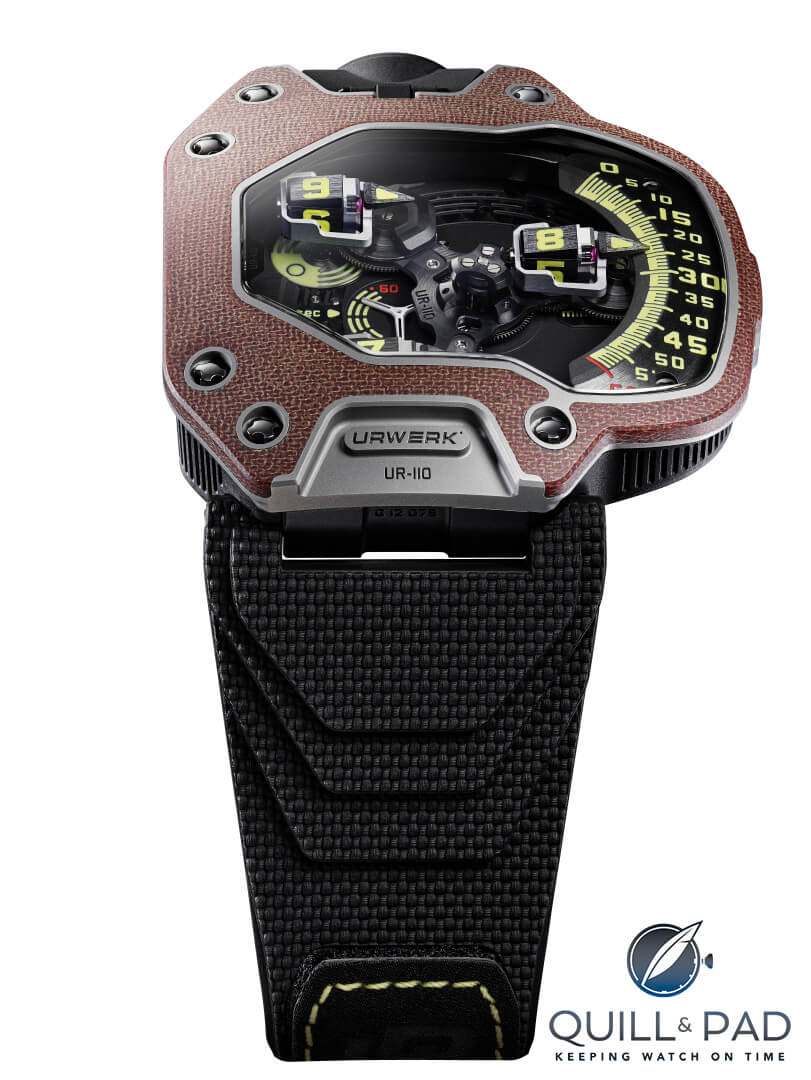
Urwerk UR-110 Bakelite
And this new piece wasn’t actually new at all: the UR-110 Bakelite was actually a formerly pre-owned UR-110 that Urwerk purchased back and used to help the collection go out with a bang.
Urwerk UR-110 Bakelite
The new watch, which is actually a manufacturer-refurbished model, features a brand-new bezel material, bezels being the feature throughout the history of the UR-110 that saw the most variance. Unsurprisingly, the UR-110 Bakelite has a bezel made of Bakelite, specifically a fiber-reinforced specimen in a medium brown subtly reminding me of the UR-110 Eastwood with timber bezel. The colors feel related, yet one is the epitome of natural materials and the other is quite literally a pioneer in synthetic materials.
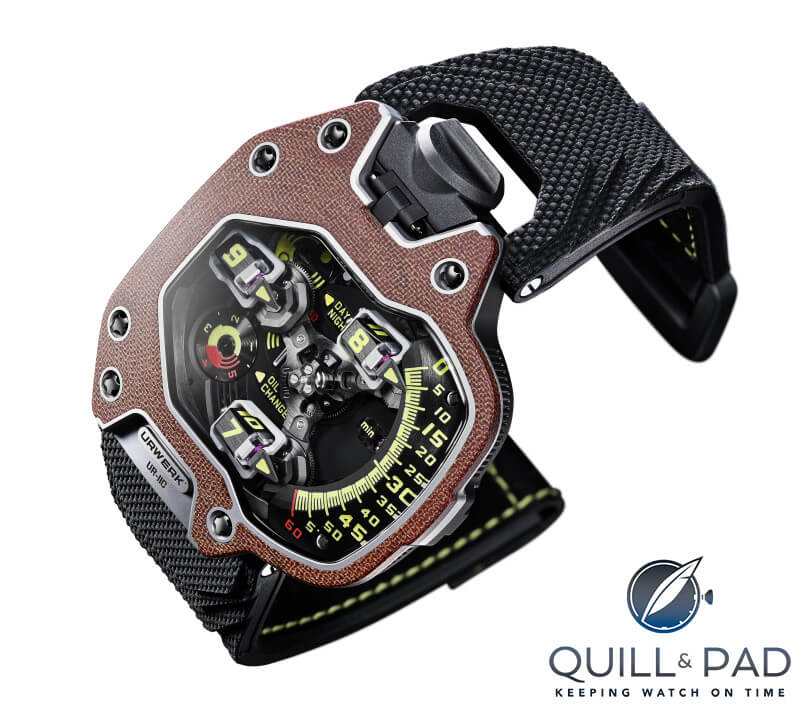
Urwerk UR-110 Bakelite
Hence with a bezel made from Bakelite the brand highlights modern material science, chemistry, and almost half a century of design formulated around one material and all its variations. Thematically this is perfect since the UR-110 has had no less than ten versions over nine editions that spanned five years. The farewell to the UR-110 line is appropriately a unique piece and was auctioned off to support the Swiss Red Cross, proving that saying so long to an iconic piece can also do some good.
But it’s 2022, seven years after the final series debuted and now over a decade after the launch of the UR-110, meaning we may need a quick refresher on the UR-110: this watch is based on the triple-armed carousel display that uses three numeral modules to display the hour and minutes. Each module relies on planetary gears to keep the arms aligned in parallel to each other and facing to the right to point to a minute scale that arcs across the edge of the watch.
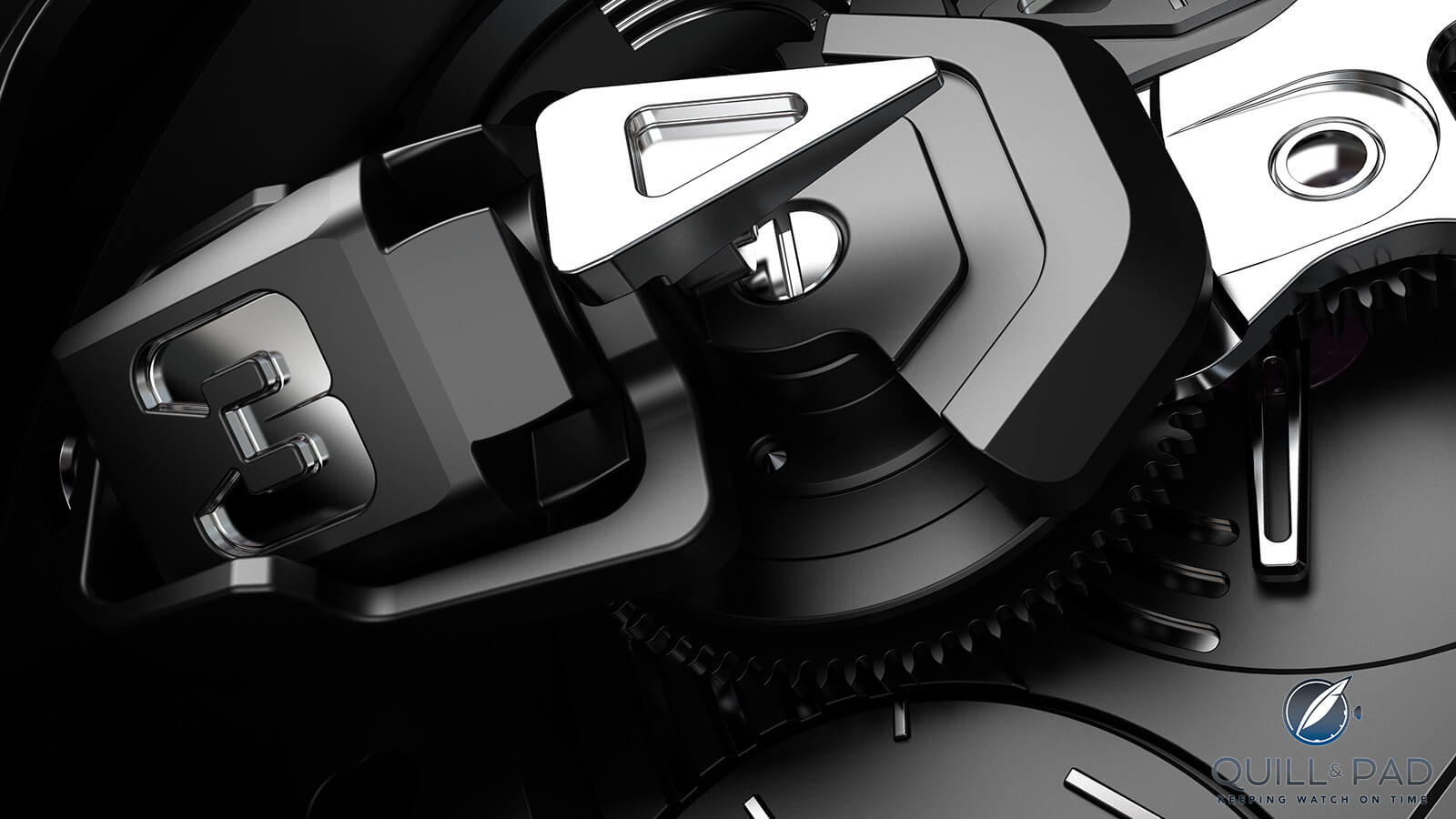
Urwerk UR-110 indicator closeup
Urwerk UR-110: mechanics
The three numeral modules have a trapezoidal prism with four numbers on each face to track the hours, rotating 90 degrees every time the carousel goes around. Unlike the UR-210 with retrograde pointer, each number module on the UR-110 has its own pointer so only the prisms need to change to cue up the next hour (in patterns such as 1, 4, 7, 10). This complex mechanical motion creates both the hour and minute displays. But there is more to see on the UR-110.
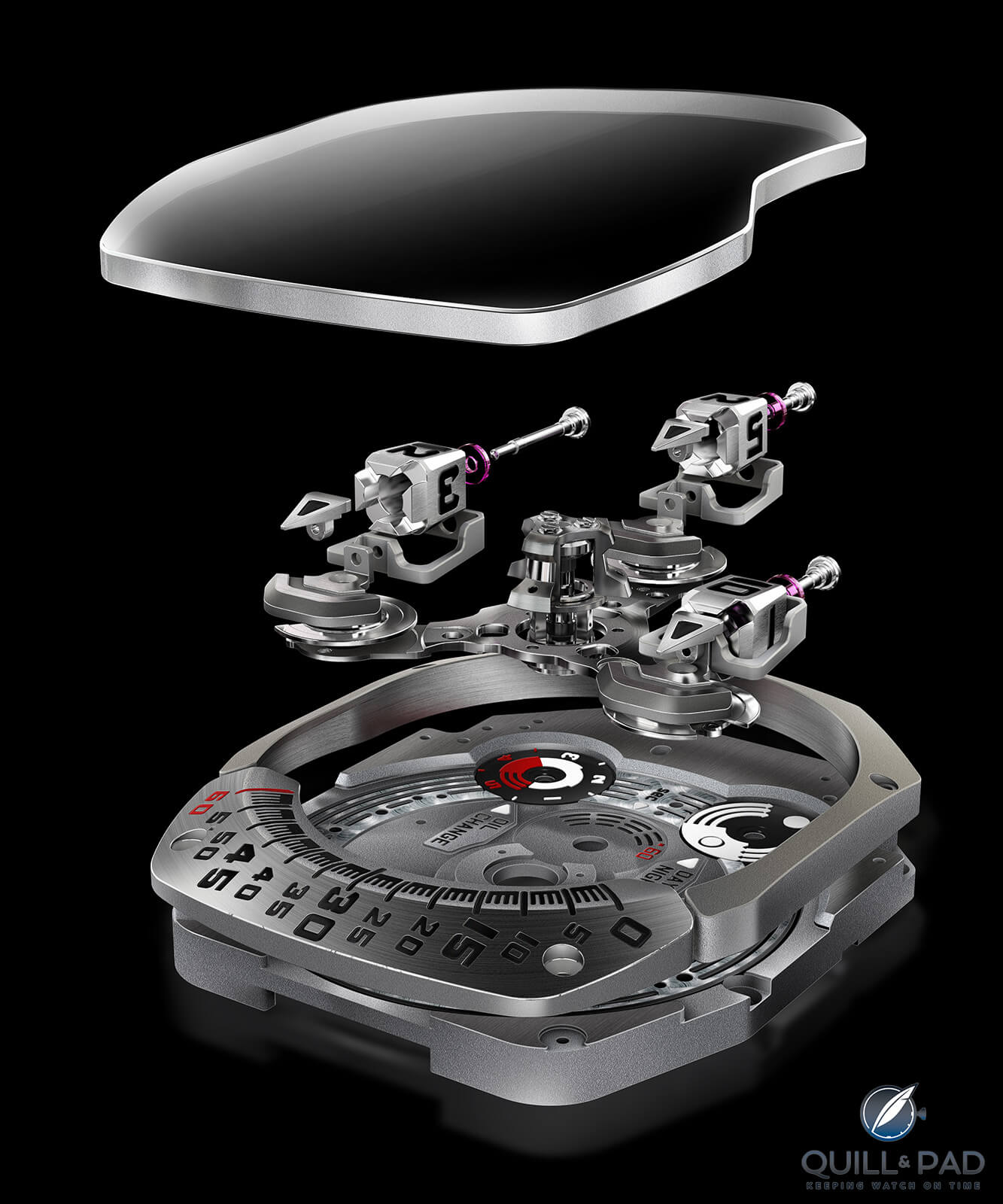
An exploded view of the Urwerk UR-110
In the upper left-hand portion of the dial, underneath the carousel, is a day/night indicator that glows brightly with applied luminous material. The day is indicated by a solid patch of lume preceded and followed by striped portions indicating dawn and dusk. Nighttime is indicated by the lack of lume save the bright dot acting as the moon.
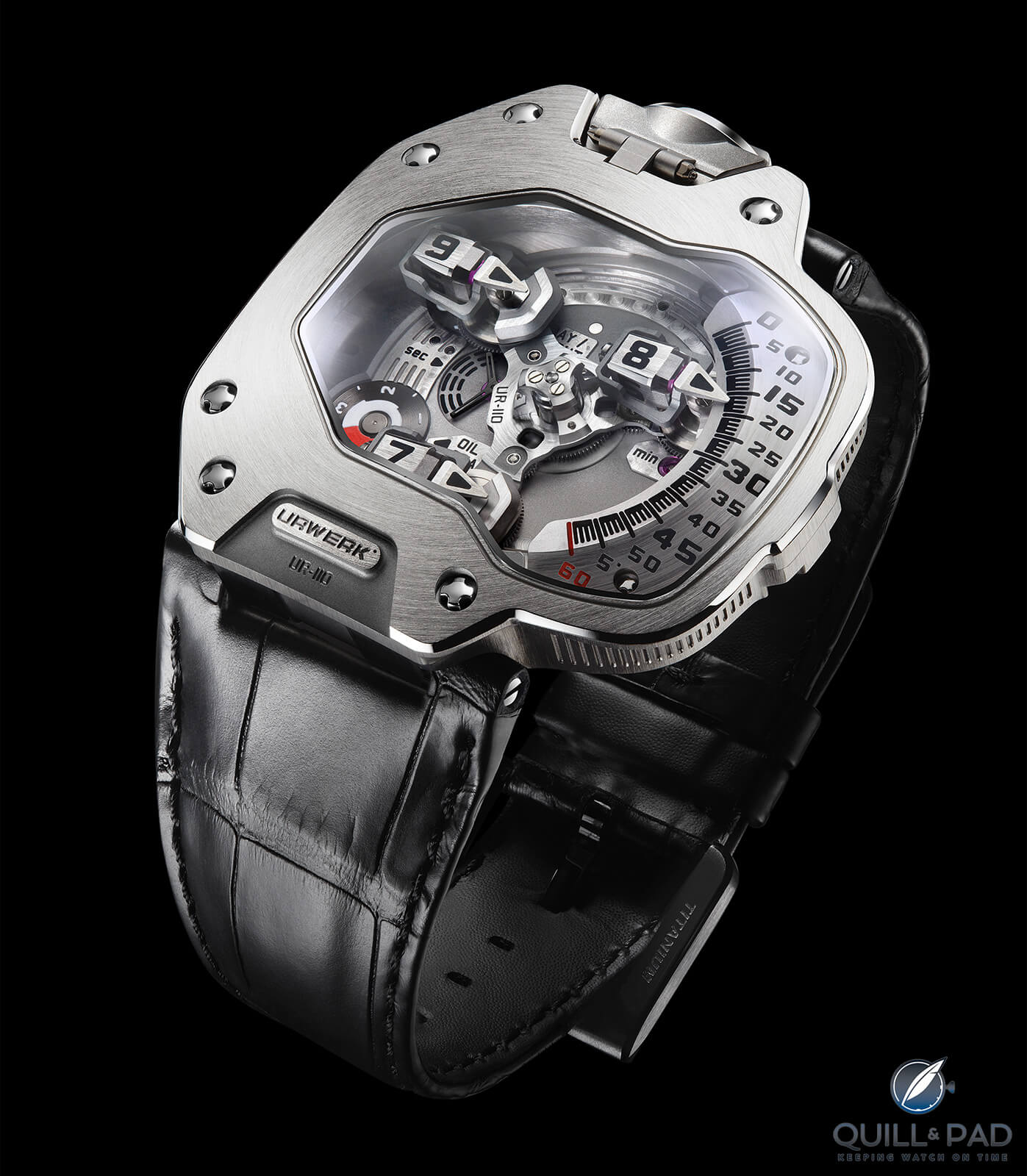
The original Urwerk UR-110 of 2011 called the Torpedo
In the center of the dial, just to the left of the central pivot of the carousel, is a continuous seconds indicator. Since it lacks any scale and only uses the number 60 to provide a reference, this display is less about accuracy or precision than showing a real-time demonstration of the timekeeping.
At the bottom left of the dial is a five-year calendar feature named the “oil change indicator.” It tracks in years the time passed since the assembly or the last service to indicate when you should send your watch back to Urwerk for service, hitting the “warning zone” in year four and the “danger zone” in the fifth and final year. Now you could be a maverick and just ignore this indicator and it would just continue on to one again since it doesn’t stop the watch from functioning, but since many avoid or ignore proper service intervals it would be smart to heed this indication.
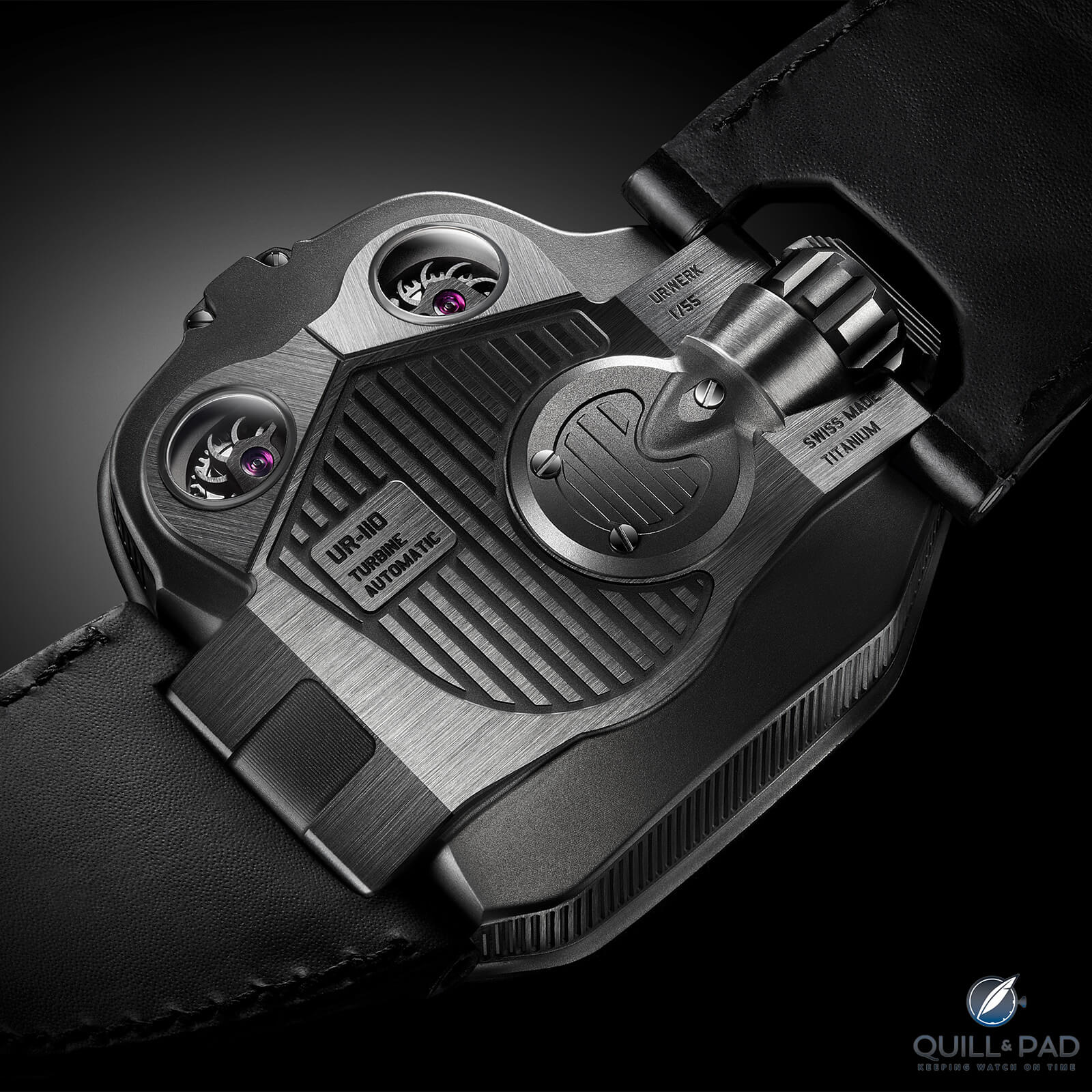
Back of the Urwerk UR-110 Torpedo
The rear of the watch is fairly simple compared to some other models from Urwerk with only two porthole windows showing the turbines that are attached to the winding mechanism. These turbines act as air brakes to keep the winding mechanism from overclocking and winding too fast in an environment where the watch is jostling aggressively. But mostly they provide an awesome sci-fi visual that perfectly complements the UR-110.
History of Urwerk UR-110 bezels and colors
So why did the makers of the UR-110 farewell version choose to focus on the bezel material for its extra bit of flair on top of all of the mechanical Urwerk goodness? As I mentioned earlier, because the bezel was a common spot for variation for earlier versions – that and the strap. The first model of this range to arrive in 2011 was the UR-110 Torpedo (pictured above) and it comprised entirely uncoated brushed titanium with a brushed steel bezel and mostly brushed titanium components on the dial that helped it look like a torpedo in the water.
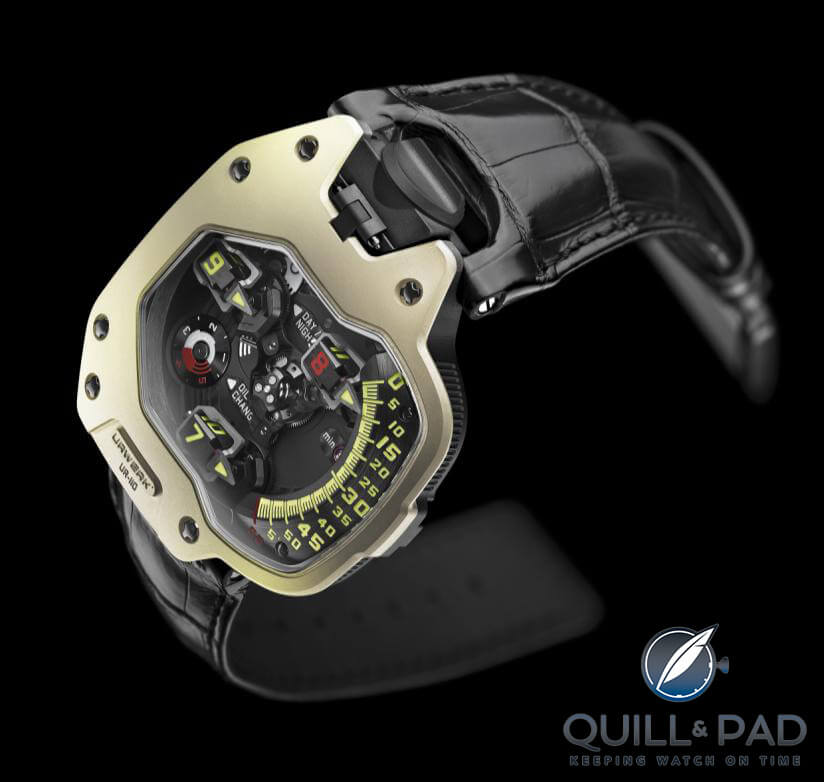
Urwerk UR-110 ZrN Champagne Supernova
This was followed at the end of 2011 with the UR-110 ZrN Champagne Supernova, whose bezel remained in steel but was glazed with Zirconium Nitride, an industrial coating pale gold in color used for cutting tools and other high-wear components that need heat resistance and high lubricity (the ability for things to be abraded but not stick to the material). This model cleverly showed its limitation number as an hour numeral in red.
That was followed up by the UR-110 AlTin Hour Glass edition in early 2012, which boasted a bezel fully in black AlTiN to match the case but had a dial with nearly all of its numerals and markers colors in light blue (a color associated with The Hour Glass Singapore).
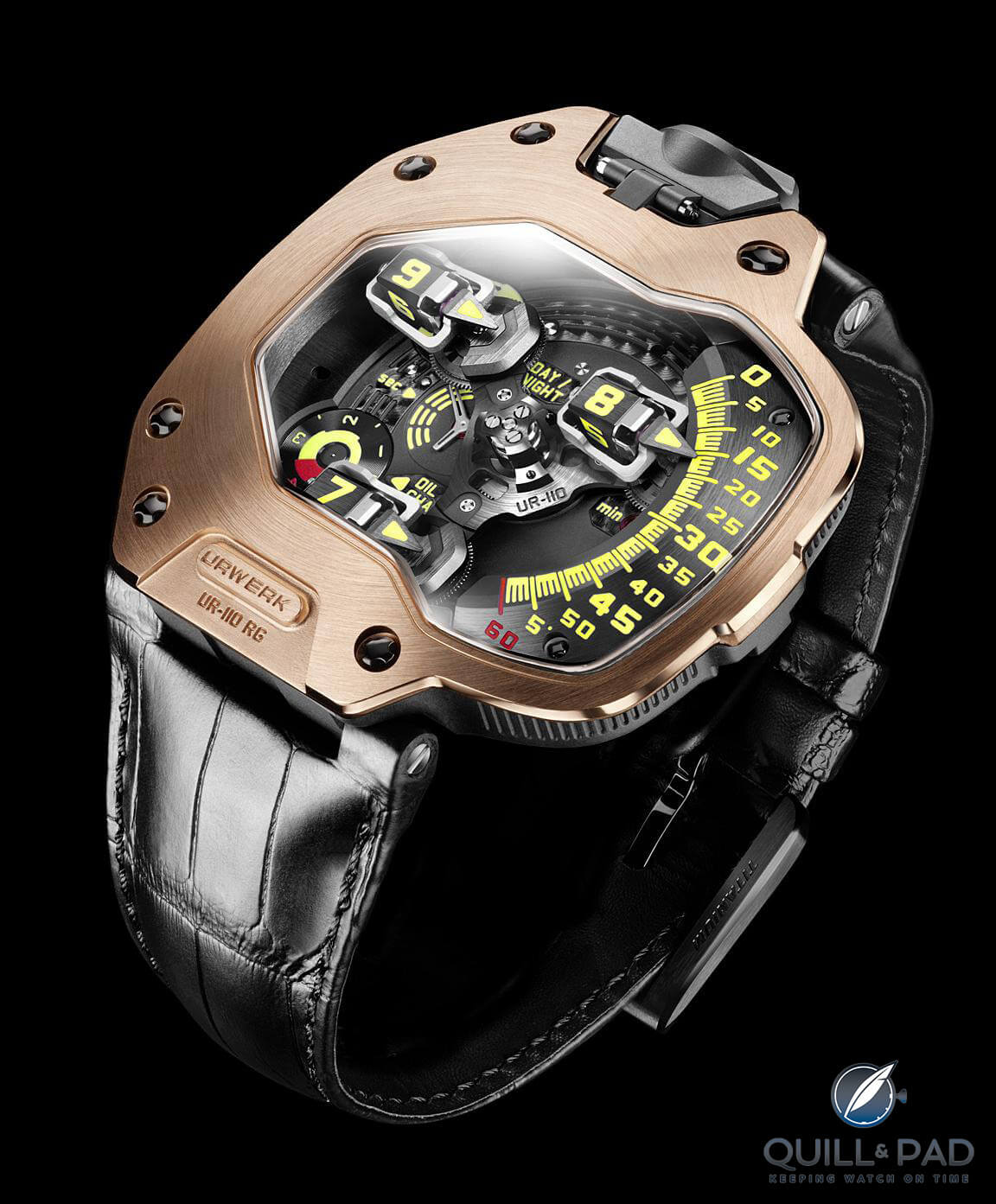
Urwerk UR-110 RG
This made for three UR-110 models with three different bezel finishes but the same materials. That changed with the fourth model released around the same time: the UR-110 RG.
RG stands for “red gold” and the model effectively followed the ZrN format but instead of a coated steel bezel it features a sumptuous, brushed red gold bezel, finally adding a dose of warmth to the UR-110. The ZrN was also a gold color, but ZrN is a cooler, pale gold color while the red gold really brings the chromatic heat. At this point it was clear Urwerk was having fun with variations, so it wasn’t a massive surprise when the company launched the UR-110 ST in March 2012.
The UR-110 ST featured a black AlTiN steel bezel once again, but this time it was engraved with grooves giving the piece a ton of physical and visual texture. These were a natural extension of grooves already machined into the side of the titanium case, so having them wrap around the bezel made perfect sense. This also demonstrated how adding texture to the bezels and cover plates of the Urwerk models would become popular in the years to come across the brand’s whole collection.
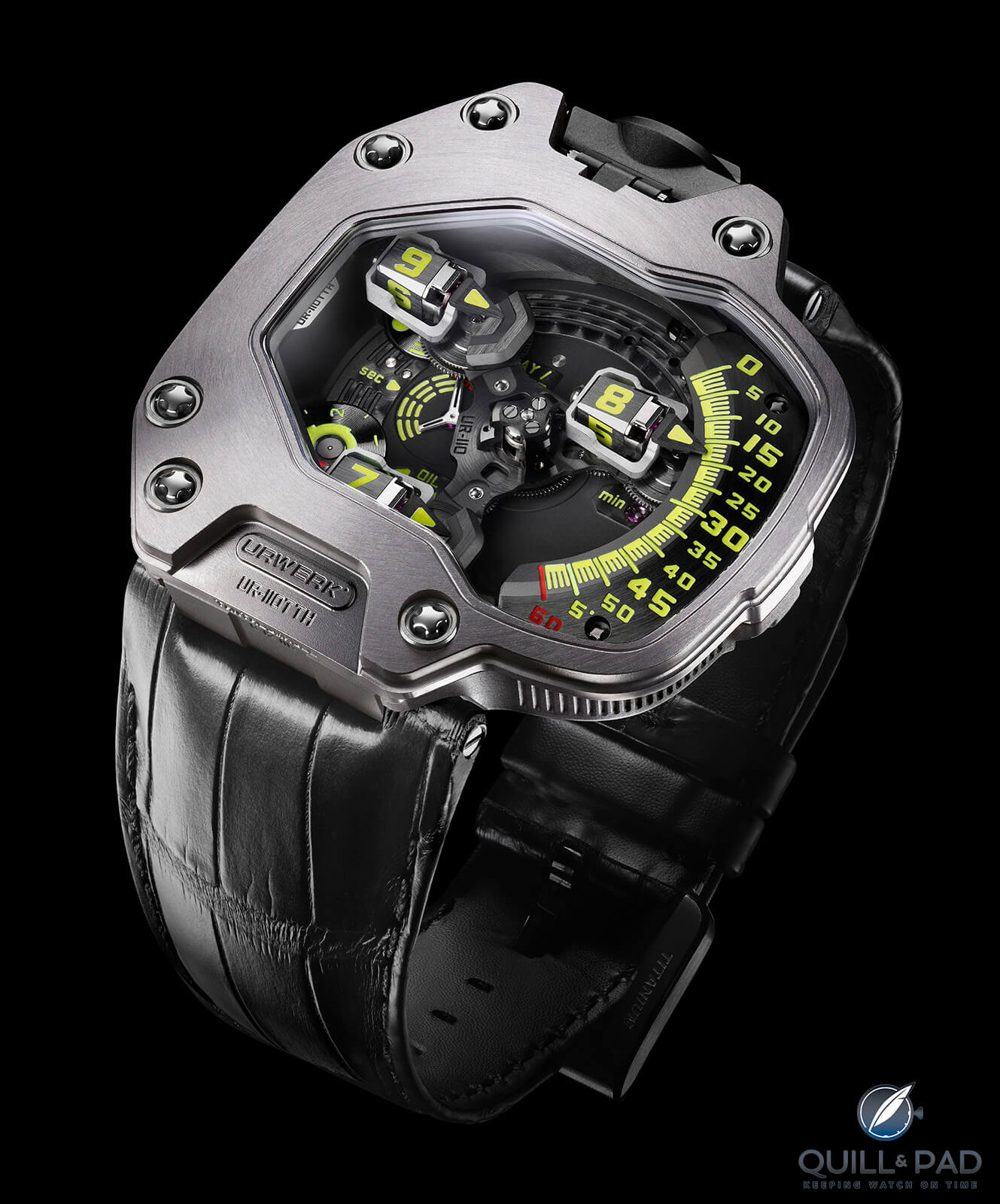
Urwerk UR-110TTH
In addition to the ST, Urwerk launched the UR-110 TTH at Baselworld 2012, which replaced the steel bezel with one made from tantalum, a very dense and difficult-to-machine metal. This bezel, double the normal thickness, made the UR-110 TTH an even more formidable watch on the wrist. The material was left satin-blasted and sat above the typical black AlTiN-coated titanium case.
Urwerk was six versions in and waited another year to drop new models, this time playing with platinum.
At Baselworld 2013, the UR-110 PT and UR-110 PTH debuted, giving us another precious-metal UR-110. The PT featured a lovely, brushed platinum bezel and the return of the light-colored dial to match the white platinum bezel. For those who still loved the dark look, however, Urwerk had them covered with the UR-110 PTH, a similar piece but with black dial components and a specially blackened bezel made of platinum.
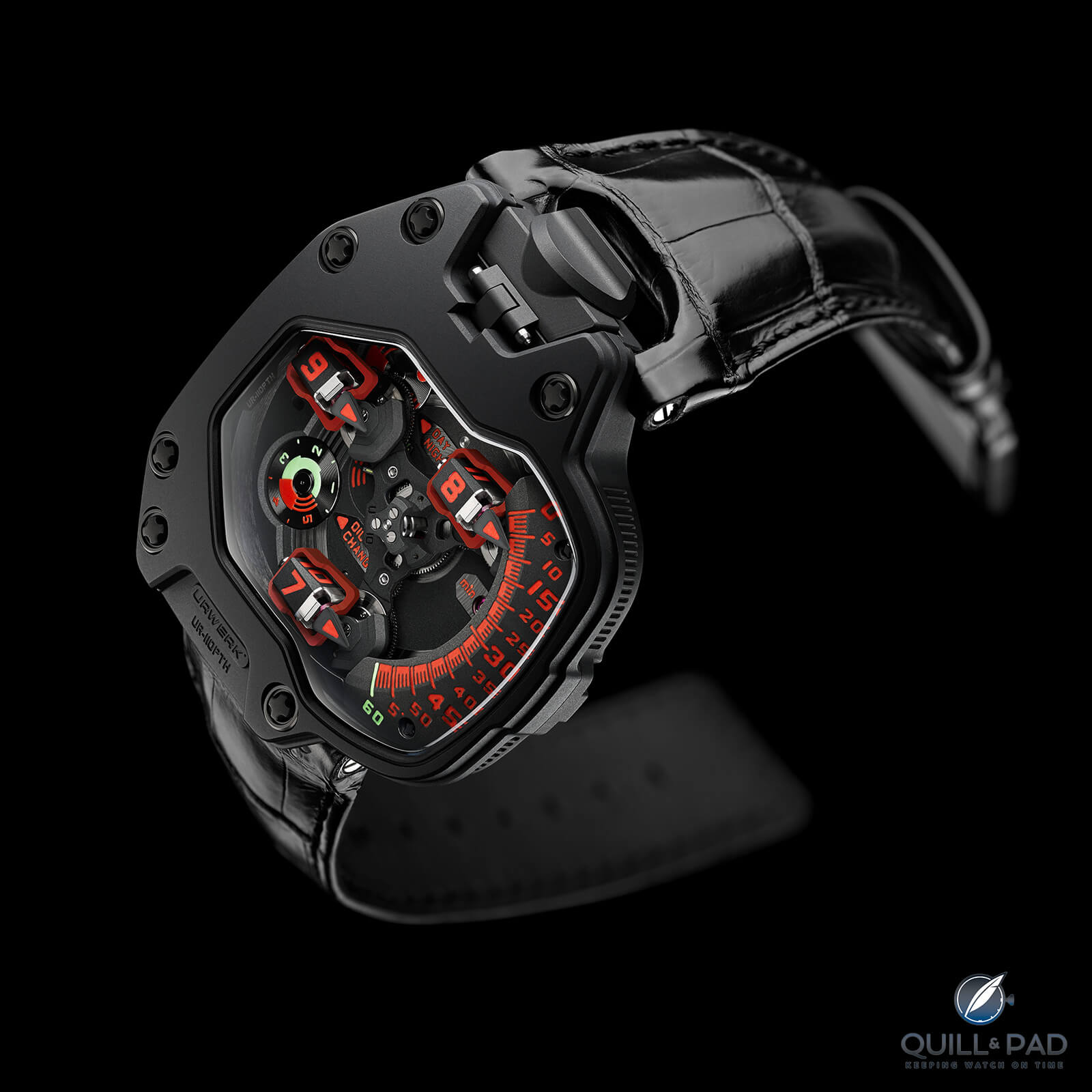
Urwerk UR-110 PTH in blackened platinum
This piece also saw another big change with the dial colors swapping to red in nearly all places. The numerals, markers, text, pointers, and even the structure surrounding the trapezoidal prisms are coated red. The distinctive red-on-black coloring totally obscures the fact the piece has a precious platinum bezel, but for many that is exactly the point.
Urwerk UR-110: coming to a close
Urwerk finished off the UR-110 collection with the “Final Series” at the end of 2014 when it launched the UR-110 Eastwood, a return to form with a twist. The case was once again the blasted and brushed uncoated titanium with a light-colored brushed and blasted dial, but the bezels were made from two choices of wood, Macassar ebony and red ebony. The natural tones of the wood are an awesome complement to the AlTiN, but the combo is set off by the addition of incredible tweed straps.

The UR-110 Eastwood looks eminently British with its Timothy Everest tweed strap
With two different tweeds to compliment the two different woods, the UR-110 Eastwood made for a particularly high note to end on for such an incredible watch design. So after nine models and ten different bezels in six different materials, the tenth-anniversary unique piece made perfect sense to dabble with a new bezel material. This is why the Bakelite, while seemingly random, was the only possible conclusion for the UR-110.
The collection had already seen precious metals like gold and platinum, engineering versions like steel, tantalum, and technical coatings, and it played with a natural material like wood, so a synthetic plastic material was a surprisingly obvious choice. The UR-110 ran a wide gamut of materials, and while it missed out on ceramics and composites, I would say that the Bakelite was an ideal conclusion.
What makes it better was that the watch was created from a pre-owned piece, making the UR-110 Eastwood the true “Final Series” and yet allowing another glimpse into the creativity of Urwerk. The piece was auctioned off in October of 2021 to support the Swiss Red Cross and ended with a hammer price of 120,000 CHF, a worthy finale for one of the best models to come from the Urwerk workshops (even ending up on the wrist of Tony Stark along the way).
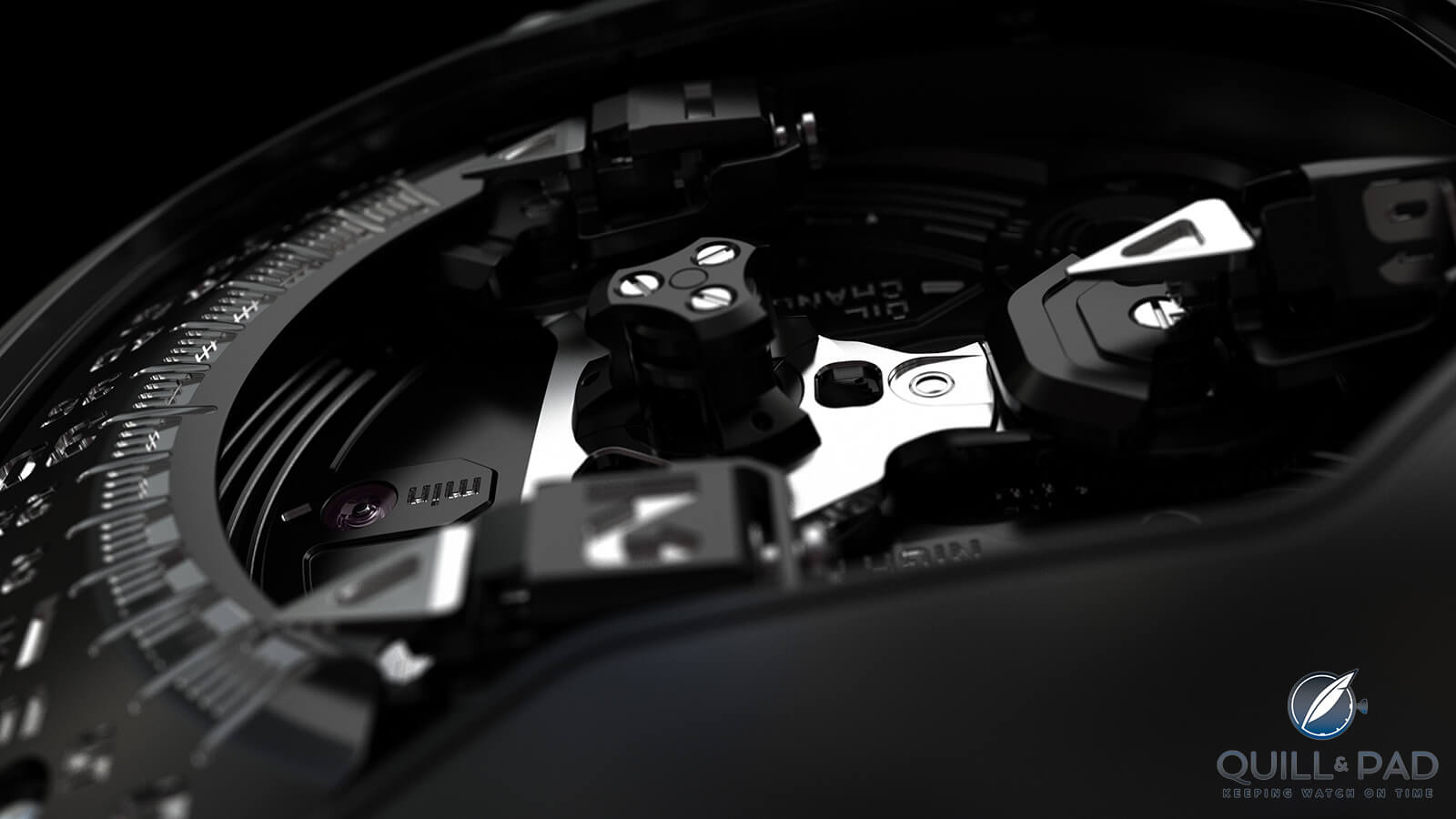
Urwerk UR-110 dial closeup
While I am sad that this likely means we won’t see another new UR-110 in the future, it also means that a new strategy for farewells has arisen for Urwerk, and we could see uniquely creative one-off pieces of other models arrive well after the final series has been delivered. This could give us fans the ability to fondly remember our favorite pieces and get one more taste before Urwerk moves on to new models.
The release of the UR-110 Bakelite also makes me excited for other unique materials Urwerk may experiment with for future models because if this piece is any indication, Urwerk watches look incredible no matter what they are clad in!
For more information, please visit urwerkpreowned.com/collections/urwerk-auction/products/ur-110-bakelite-unique-piece.
Quick Facts Urwerk UR-110 Bakelite
Case: 47 x 51 x 16 mm, titanium with Bakelite bezel
Movement: automatic winding Caliber UR-9.01, 39-hour power reserve, 28,800 vph/4 Hz frequency
Functions: satellite hours, minutes, seconds, day/night indicator, oil change indicator
Limitation: unique piece auctioned for charity
Final hammer price: CHF 120,000
Listing of Urwerk UR-110 timepieces
2011: UR-110 Torpedo. First edition, titanium. Won the 2011 Grand Prix d’Horlogerie de Genève Design Watch
2011: UR-110 ZRN Champagne Supernova. Steel bezel with Zrn coating
2012: UR-110 AlTin Hourglass Edition. Blue markings
2012: UR-110 RG. Red gold
2012: UR-110 ST. Engraved steel bezel
2012: UR-110 TTH. Tantalum hull
2013: UR-110 PT. Platinum bezel
2013: UR-110 PTH. Blackened platinum bezel
2014: UR-110 Eastwood. Final series, wood bezels and tweed straps
2021: UR-110 Bakelite. Farewell tenth-anniversary unique piece
You may also enjoy:
The Urwerk UR-110 Eastwood: A Tailor-Made Farewell Of Timber And Tweed
Heartbeat: The High-Lume-Glow-In-The-Dark Urwerk UR-110 TTH
Urwerk UR-220 Rides Into A Golden Sunset With Its Final Edition
Urwerk UR-100V Time And Culture: 27-Ton Aztec Sun Stone Miniaturized For The Wrist
Leave a Reply
Want to join the discussion?Feel free to contribute!





















































Is this bezel material any different from Micarta? It looks and sounds like Micarta.
You are correct that they are effectively the same. Micarta was a later product that was based on the patents developed by Leo Baekeland, and used similar materials though it was different, at least until the patents expired. Bakelite was the more popular product but Micarta, along with other imitations and derivations popped up pretty quickly as it was a major breakthrough in composite polymer technology.